- Home
- The Autumn Garden
- Autumn Berries
Autumn Berries and Fruits Add
Interest to the Fall Garden
Some outstanding garden plants reward us with beautiful autumn berries, fruits, cones, nuts, seeds or seed pods in the fall. Don't neglect to include some of these in your garden, and you'll have plenty of interest outdoors as well as material for beautiful fall arrangements.
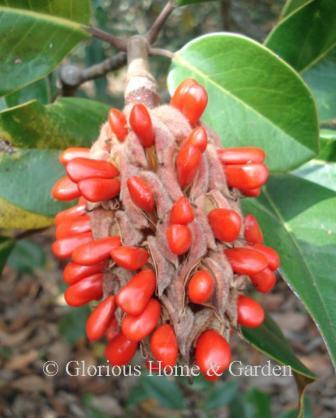 Magnolia grandiflora seedpod
Magnolia grandiflora seedpodAcer buergerianum, trident maple, Zones 5-9. Winged seeds (samaras) ripen in the fall and are often very abundantly produced.
Ampelopsis brevipedunculata, porcelain berry vine, Zones 4-8. Fascinating autumn berries change from green, to turquoise, to lilac, to purple, and finally to blue as they mature. I've seen them growing wild on Cape Cod near the seashore. Can be invasive.
Anemone japonica hybrids, Zones 5-7. The seedpods are very interesting and ornamental in the garden in the late fall. They look like cotton balls, studded with tiny seeds like strawberries. A good way to increase your anemones is to pick the seedpods when ripe, place them in a paper bag or paper towels to save the seeds for propagation.
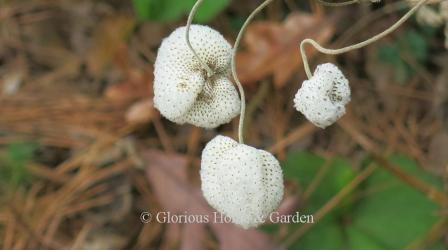 Anemone x 'September Charm' seedpods
Anemone x 'September Charm' seedpodsArbutus unedo, strawberry tree, Zones 7-9. This is an unusual small tree that blooms fall into winter with panicles of small white flowers sort of like a pieris. The striking orangey-red fruits, which resemble a strawberry, ripen the following fall and often appear at the same time as the new flowers appear. Add evergreen foliage and beautiful bark to boot, and you have an interesting ornamental that deserves wider planting.
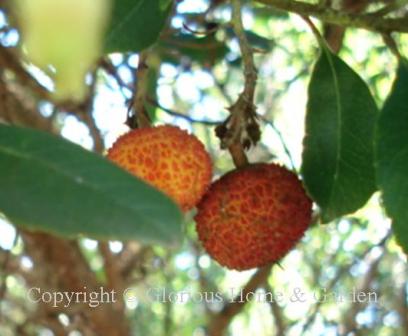 Arbutus unedo
Arbutus unedoArum italicum, Italian arum, Zones 6-9. An interesting woodland plant to grow for its leafless stalk of red autumn berries in late summer and fall that look like little ears of Indian corn on a stick. Leaves follow the berries and remain all winter.
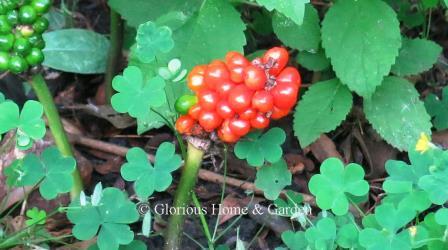 Arum italicum
Arum italicumAsclepias tuberosa, butterfly weed, Zones 4-9. At the end of the season, the elongated seedpods ripen and burst open to reveal brown seeds each attached to silky white filaments. Let them open and spill in the garden if you wish to have more butterfly weed, otherwise, cut off the pods before they split open to use in flower arrangements.
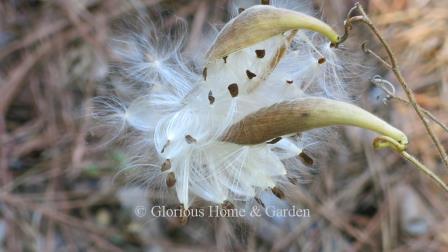 Asclepias tuberosa seeds
Asclepias tuberosa seedsBerberis thunbergii, Japanese barberry, Zones 4-8. Japanese barberries come in a variety of sizes, shapes and leaf colors and thus they can be used in many situations such as screens, hedges, and barriers due to their spiny stems. 'Kobold' (pictured) is a low rounded cultivar that reaches about 24-30" and produces bright red oblong berries that persist into winter.
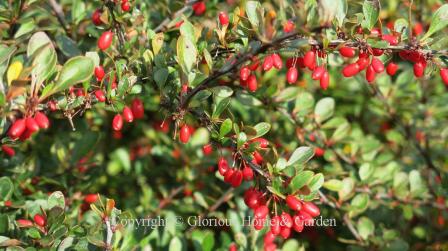
Autumn Berries: Beautyberries
Beautyberries are well-named. The abundance of striking white, blue, purple, violet or mauve autumn berries that they produce is outstanding and highly ornamental in the garden.
Callicarpa acuminata, Mexican beautyberry, Zones 7-10. This species has deep mulberry purple, almost black fruits. Highly ornamental color and great en masse.
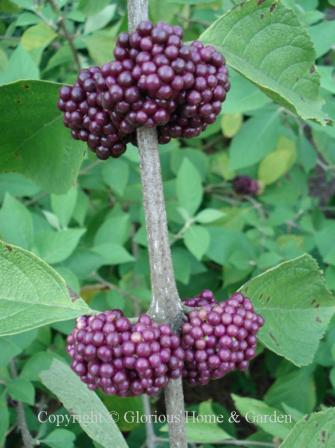 Callicarpa acuminata
Callicarpa acuminataCallicarpa americana, American beautyberry, Zones 6-11. One of our most outstanding native shrubs for autumn berries. Gorgeous violet berries encircle the stem nodes. They begin coloring in late August in Georgia and persist a long time. There is also a white-fruited form.
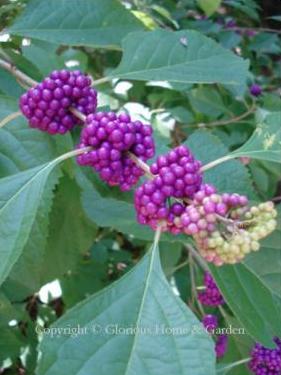 Callicarpa americana
Callicarpa americanaCallicarpa bodinieri var. giraldii, Bodinier beautyberry, Zones 6-8. Bodinier beautyberry produces lilac blue berries that are smaller in size than C. americana.
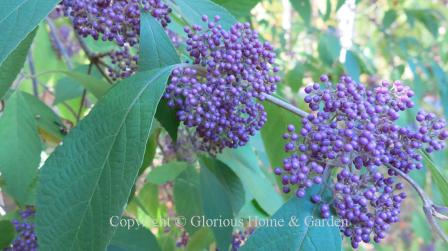 Callicarpa bodinieri var. giraldii
Callicarpa bodinieri var. giraldiiCallicarpa cathayana, Chinese beautyberry, Zones 5-8. This species of beautyberry boasts lighter mauve-pink berries.
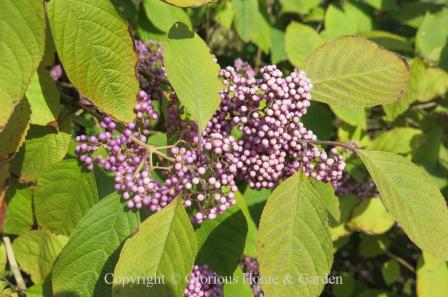 Callicarpa cathayana
Callicarpa cathayanaCallicarpa dichotoma, purple
beautyberry, Zones 5-8. If you have room
for only one beautyberry in your garden, consider this one. Graceful, arching branches are loaded with
violet fruits in late summer into fall. The
berries are smaller than those of American beautyberry, and cluster on top of
the stems rather than encircling them.
There is also a white-berried form called C. dichotoma var. albifructus.
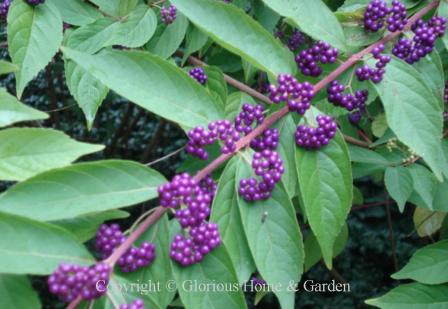 Callicarpa dichotoma
Callicarpa dichotomaCallicarpa japonica, Japanese beautyberry, Zones 5-8. Striking metallic blue fruits show off well against the yellowing foliage in October. A great cultivar of it is ‘Heavy Berry,’ which produces a prodigious amount of fruit. Outstanding for a mass planting.
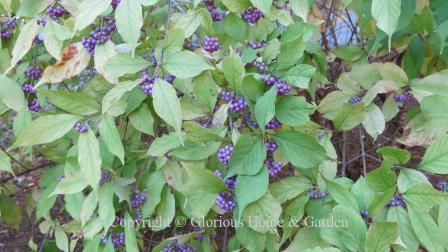 Callicarpa japonica
Callicarpa japonica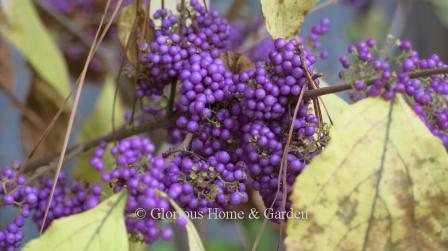 Callicarpa japonica 'Heavy Berry'
Callicarpa japonica 'Heavy Berry'Celastrus scandens, American bittersweet, Zones 3-8. A very vigorous vine with yellow to orange seed capsules that open to reveal orange-red seeds. Nice to have for fall arrangements, but unless you have an area to contain it in or an eyesore to cover, perhaps best to just buy some. Celastrus orbiculatus, Chinese bittersweet, is an invasive, non-native plant that should not be planted.
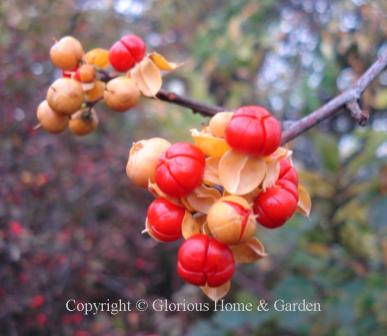 Celastrus scandens
Celastrus scandensChionanthus retusus, Chinese fringetree, Zones 6-8. Perhaps better known for its clouds of white spring flowers, this tree also shines in the autumn when it produces pendulous clusters of dark blue grape-like drupes.
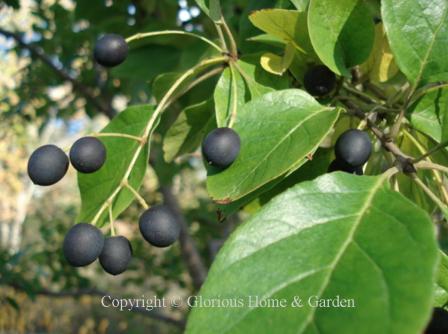 Chionanthus retusus
Chionanthus retususClerodendrum trichotomum, harlequin glorybower, Zones 7-9. The harlequin glorybower is an attention-getter for sure when the red calyxes reflex back to reveal the blue fruit inside--the effect is like a shooting star. Blooming in late summer and often into fall, sometimes the fragrant, tubular white blooms will be present at the same time as the fruit.
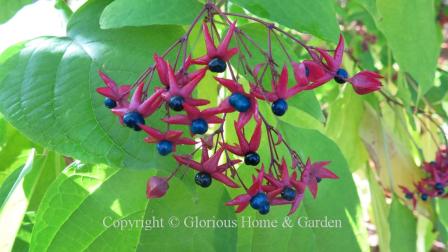 Clerodendrum trichotomum
Clerodendrum trichotomumConvallaria majalis, lily-of-the-valley, Zones, 3-8. Known more for its sweetly scented white nodding bell flowers in spring, you will also sometimes see bright orange to red berries in the fall that are quite charming and ornamental.
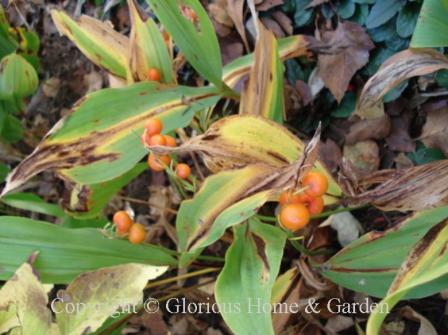
Autumn Berries: Dogwoods
Cornus canadensis, bunchberry, Zones 2-6. A beautiful groundcover of the dogwood family for moist, acidic Northern woodland gardens, it produces a little bunch of red berries rising from the center of each plant.
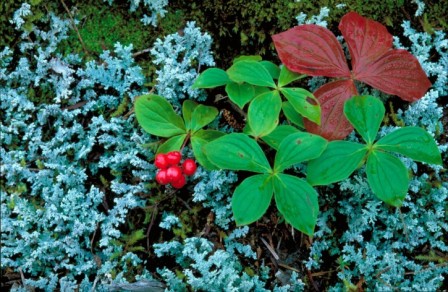 Cornus canadensis
Cornus canadensisCornus florida, flowering dogwood, Zones 5-9. One of our most beautiful native flowering trees, lovely in all seasons. In fall, the clusters of red berries ripen in late summer and fall and persist a long time until eaten by birds, often sparkling through the red fall foliage.
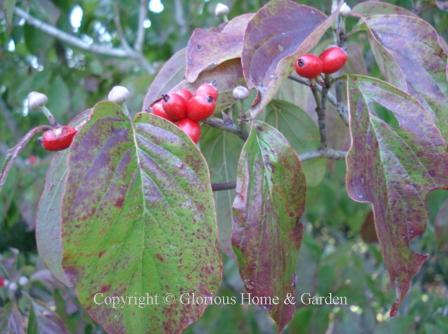 Cornus florida
Cornus floridaCornus kousa, Kousa dogwood, Zones 5-8. The globular red raspberry-like fruits of this dogwood are very different from that of Cornus florida, and highly ornamental.
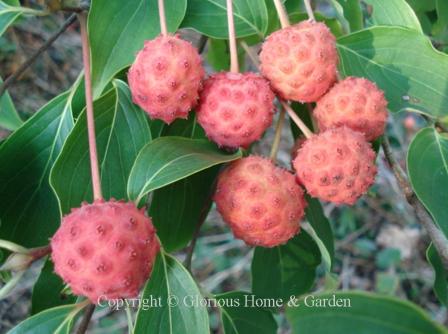 Cornus kousa
Cornus kousaCornus racemosa, gray dogwood, Zones 4-8. This is a smallish tree--or more typically a large shrub--that can get up to about 15' tall. Due to the nature of its suckering roots, it can form large colonies, so must be placed with care. That said, the grayish-white berries that ripen in fall are ornamental--until the birds devour them--and the red stems of the berries are a striking color contrast.
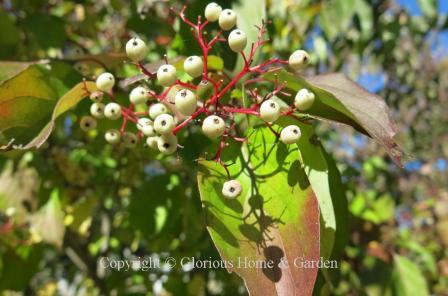 Cornus racemosa
Cornus racemosaCotoneaster salicifolius, willowleaf cotoneaster, Zones 6-7. Bright red autumn berries are heavily produced on this wide-spreading evergreen shrub. The species can grow quite large, but there are smaller cultivars that make excellent ground cover shrubs.
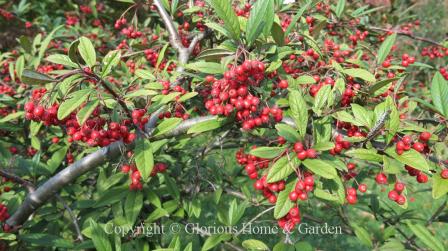 Cotoneaster salicifolius
Cotoneaster salicifoliusCrataegus crusgalli, cockspur hawthorn, Zones 4-7. Dark red berries ripen in the fall on this large tree which can reach 3o’. Caveat: Beware the long, sharp thorns!
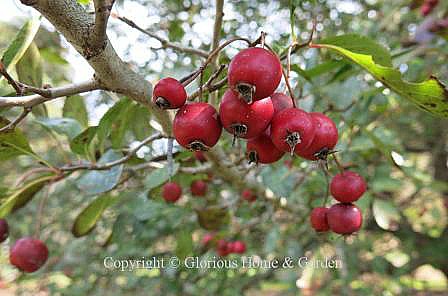 Crataegus crusgalli 'Hooks'
Crataegus crusgalli 'Hooks'Diospyros kaki, Japanese persimmon, Zones 8-9. No, those are not eggs hanging from the
branches! Very decorative
orange fruits ripen after the leaves fall (which also make a colorful
show) and look like suspended eggs, making this an outstanding choice for the border or as a
specimen. This is 'Pendula,' the weeping variety of Japanese persimmon, which has elongated egg-sheped fruits.
Euonymus alatus, winged euonymus, Zones 4-8. Not only do the leaves turn brilliant shades of red in the fall, but bright red seeds dangle like little jewels at the same time. They tend to hide beneath the leaves, so they reward the close observer.
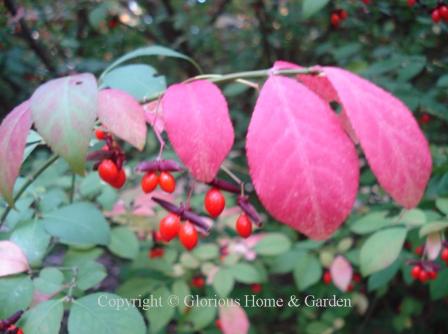 Euonymus alatus
Euonymus alatusEuonymus americanus, strawberry bush, or hearts-a-burstin’, Zones 5-8. Native to forests of the eastern United States. In fall, bumpy red seed capsules burst open to reveal the red seeds within hence the common name. Interesting for a native plantscape, but the leaves and fruits are poisonous.
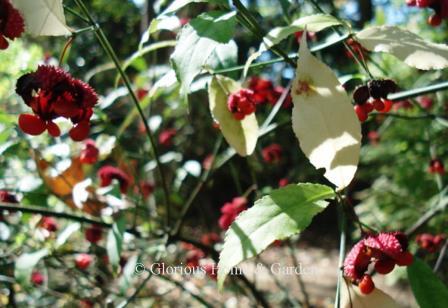 Euonymus americanus
Euonymus americanusEuscaphis japonicus, sweetheart tree, Zones 7-8. Unusual small tree with red pods that open in the fall to expose black seeds. Very ornamental for the autumn garden. Picture below taken at the Daniel Stowe Botanical Garden in Belmont, N.C.
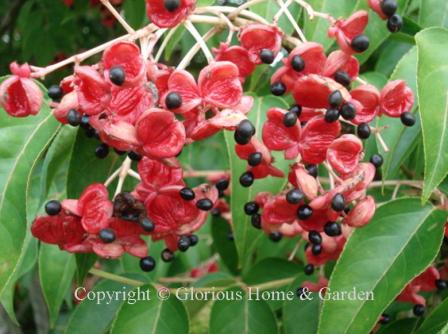 Euscaphis japonicus
Euscaphis japonicusAutumn Berries: Hollies
Ilex decidua, possumhaw holly, Zones 5-9. A a great native American holly for autumn berries. Possumhaw holly produces prodigious quantities of fruit. Very ornamental, but needs room as they can get quite large (about 15' -20'). 'Red Cascade' shown below taken at Daniel Stowe Botanical Gardens in Belmont, N.C.
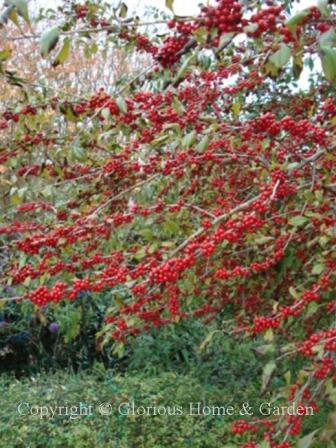 Ilex decidua
Ilex deciduaIlex verticillata, winterberry holly, Zones 3-9. Spectacular deciduous holly for color from fall through winter (until the birds strip the branches). When the leaves drop the abundant autumn berries really stand out. Plant a male pollinator, such as 'Southern Gentleman' among a group of female bearers like 'Berry Nice,' or 'Winter Red.'
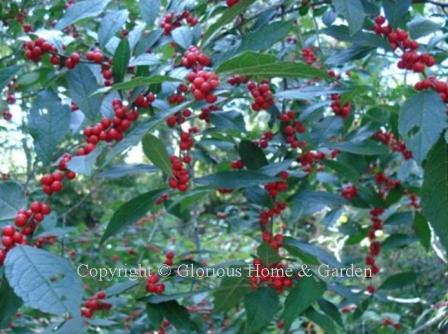 Ilex verticillata
Ilex verticillataIlex vomitoria, Yaupon holly, Zones 7-10. Brilliant red autumn berries make this holly highly ornamental fall until spring in areas where winters are milder. The weeping form I. vomitoria 'Pendula' makes a beautiful specimen. 'Katherine' is a particularly good yellow-fruited form.
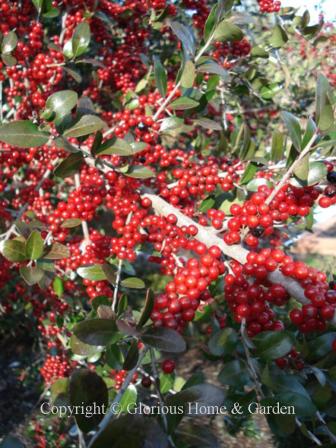 Ilex vomitoira
Ilex vomitoiraIris domestica,
blackberry lily, Zones 5-10. The seed pods split open in the fall to
reveal clusters of shiny black seeds that resemble blackberries. Formerly known as Belamcanda chinensis.
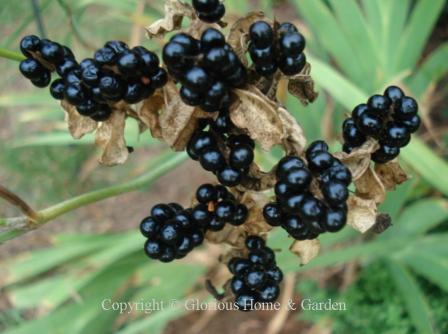 Iris domestica
Iris domesticaKoelreuteria bipinnata, Chinese flame tree, Zones 6-8. I love these papery, puffy, pinkish seedpods in the fall. They are very ornamental, and look like little Chinese lanterns. The pods follow the long panicles of yellow flowers that bloom in late summer when little else is blooming. The picture below was taken at the Daniel Stowe Botanical Garden in Belmont, N.C.
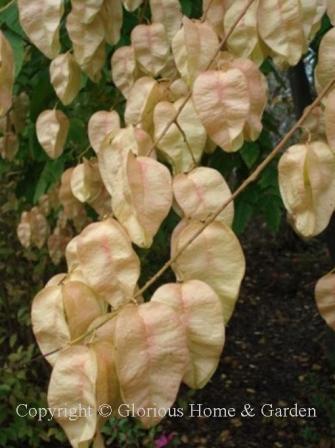 Koelreuteria bipinnata
Koelreuteria bipinnataMagnolia grandiflora, Southern magnolia, Zones 7-10. Large velvety cone-like fruits ripen in the fall to a lovely rose-red then split open to reveal the red seeds. Quite handsome on a large mature tree and interesting to use for decorations.
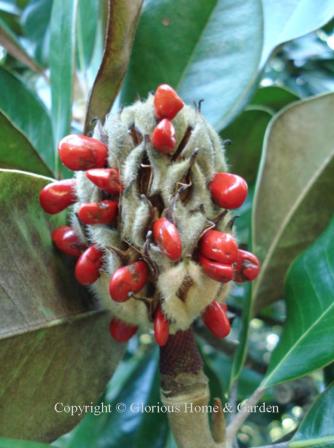 Magnolia grandiflora
Magnolia grandifloraMalus, crabapples, Zones 4-7. There are hundreds of cultivars. Check with your local nursery for disease-resistant varieties recommended for your area. Some cultivars noted for their ornamental fruit are 'Autumn Treasure,' 'Bonfire,' 'Donald Wyman (pictured below),' 'Jewelberry,' 'Molten Lava,' 'Red Jade,' M. sargentii, 'Sentinel,' ' Sugar Tyme.' Fruit often persists through winter until eaten by birds.
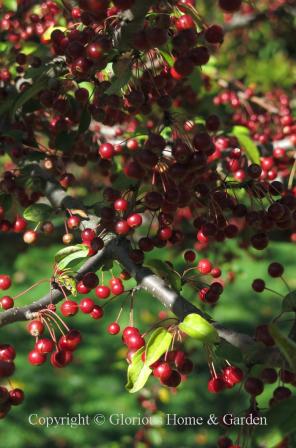 Malus 'Donald Wyman'
Malus 'Donald Wyman'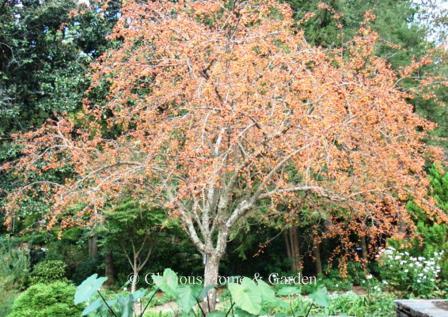 Malus 'Indian Summer'
Malus 'Indian Summer'Malus sargentii, Sargent crabapple, Zones 4-7. An excellent crabapple with good disease resistance. This spreading crabapple is smothered in a cloud of white blooms in spring and is followed by heavy fruit production in the fall which is quite ornamental.
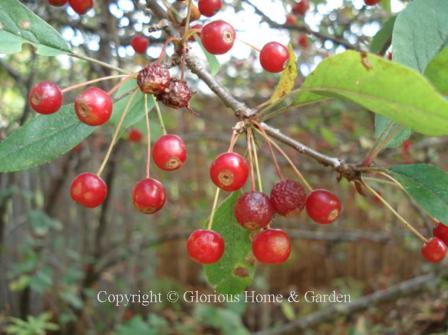 Malus sargentii
Malus sargentiiMorella cerifera (formerly Myrica cerifera), Southern waxmyrtle, Zones 7-11. The Southern equivalent of the Northern bayberry. A fast growing plant, and birds love the berries.
Morella pensylvanica (formerly Myrica pensyulvanica), Northern bayberry, Zones 3-6. The female plants produce the small gray, waxy berries that are used to make fragrant bayberry candles. Good to use in a coastal environment.
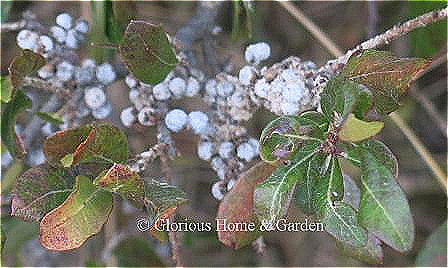 Morella pensylvanica
Morella pensylvanicaNandina domestica, heavenly bamboo, Zones 6-9. The large pendulous clusters of orange-red autumn berries are long-lasting and a favorite for Christmas decorations.
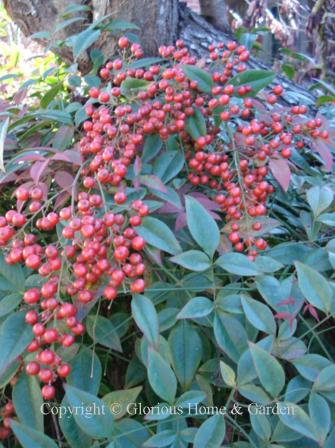 Nandina domestica
Nandina domesticaPunica granatum, pomegranate, Zones 8-10. Pomegranates ripen in the fall and have become very popular to use for holiday decorations.
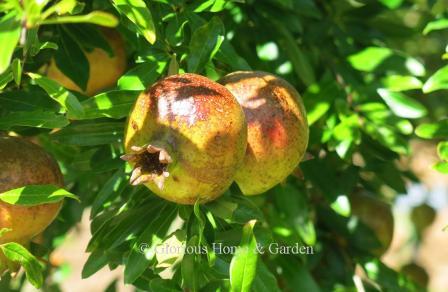 Punica granatum 'State Fair'
Punica granatum 'State Fair'Pyracantha coccinea, scarlet firethorn, Zones 6-9. Usually very abundantly produced and showy orange to red autumn berries that can persist a long time. Can be trained as an espalier on a wall. Beware of the thorns!
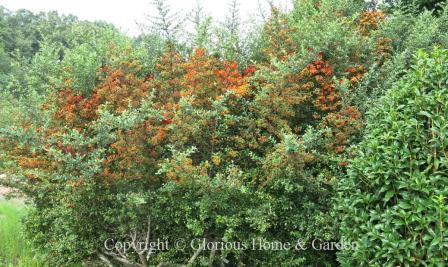 Pyracantha coccinea Mohave
Pyracantha coccinea MohaveRosa eglanteria, eglantine or sweetbriar rose, Zones 4-10. The rose of Shakespeare not only has apple-scented foliage and sweetly-scented flowers, but its oval hips persist through winter. Said to be a very long-lived rose.
Rosa foliolosa, leafy or prairie rose, Zones 6-10. This rose is native to the southern mid-western states.. It has few thorns, and produces bright pink fragrant flowers followed by numerous hips and good fall color. The name comes from the abundance of narrow leaves.
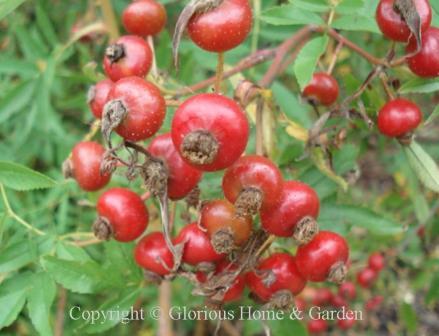 Rosa foliolosa hips
Rosa foliolosa hipsRosa glauca, redleaf rose, Zones 2-7. This rose is worth growing for the purplish (some say blue) leaves as for the rounded, red hips with long sepals.
Rosa laevigata, Cherokee rose, Zones 7-9. Large white blooms in spring are followed by prickly hips in fall.
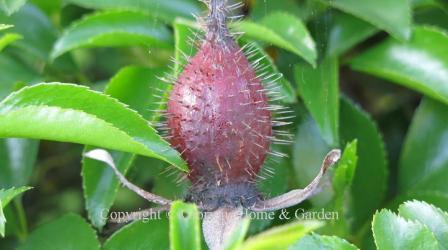 Rosa laevigata hip
Rosa laevigata hipRosa moyesii, Moyes rose, Zones 5-7. Clusters of elongated red hips are produced abundantly and are quite decorative in the fall.
Rosa rugosa, beach rose, Zones 2-7, long-lasting large tomato-like hips form in late summer through fall and are very decorative. Can be used to make jams, jellies and teas.
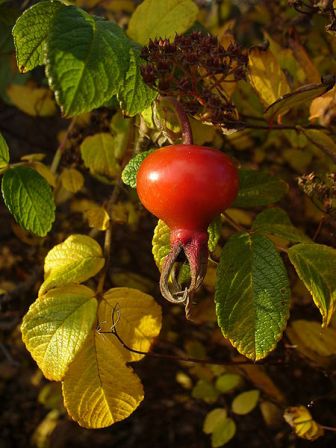 Rosa rugosa
Rosa rugosaSymphoricarpos albus, snowberry, Zones 3-7. A native American shrub with distinctive white autumn berries. Not an outstanding plant in the garden, but good for shady locations. Interesting to use in fall arrangements.
Symphoricarpos orbiculatus, coralberry or Indian currant, Zones 2-7. This is a small native shrub with arching branches that could be effectively used in a woodland garden, as an informal hedge or to control erosion. The flowers are inconspicuous, but the slender branches are laden with pinkish-purple autumn berries that persist through winter providing food for birds. 'Central Avenue' (pictured at the Daniel Stowe Botanical Garden), was apparently discovered on Central Avenue in Madison, Georgia in dry, shady conditions, and is used effectively here with purple ajuga.
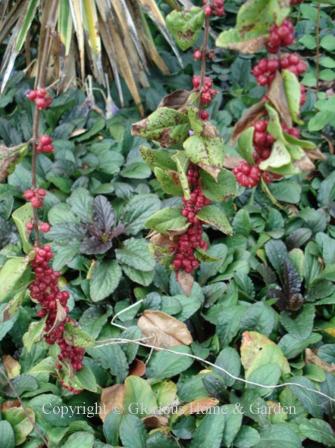 Symphoricarpos orbiculatus
Symphoricarpos orbiculatusSymplocos paniculata, sapphireberry, Zones 4-8. Lovely sapphire-blue berries in the fall. Appreciate them before the birds devour them!
Autumn Berries: Viburnums
Viburnums are among the best shrubs for fall color and autumn berries, rivaling hollies for the honor. Some viburnums are best for spring bloom and fragrance, these below are outstanding for their fruit.
Viburnum dilatatum, linden viburnum, Zones 5-7. Excellent choice for the garden border due to its showy white bloom in the spring, fall leaf color and outstanding autumn berries. The fruits resemble cranberries and indeed look like dried cranberries by the end of winter, but that is when the birds prefer them when not much else is available. 'Asian Beauty,' 'Cardinal Candy,' 'Erie,' 'Oneida' are all good selections. Must have another cultivar in vicinity for good pollination and fruit set. 'Michael Dodge,' shown below, has yellow fruits. Prefers the cooler temps of the North (I am jealous!), or try in partial shade in the South with consistent moisture, but good drainage.
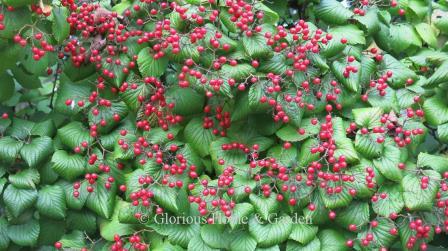 Viburnum dilatatum 'Asian Beauty'
Viburnum dilatatum 'Asian Beauty'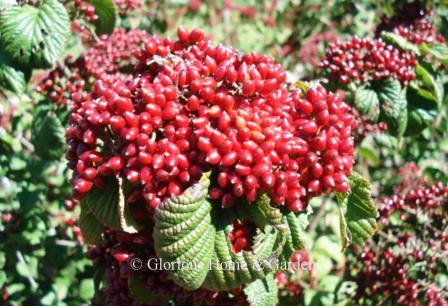 Viburnum dilatatum 'Cardinal Candy'
Viburnum dilatatum 'Cardinal Candy'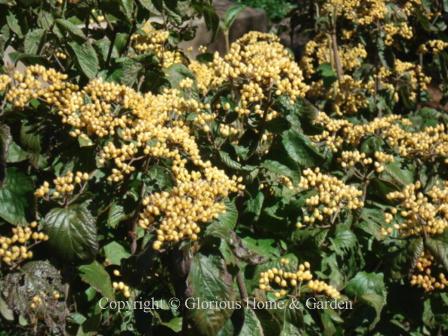 Viburnum dilatatum 'Michael Dodge'
Viburnum dilatatum 'Michael Dodge'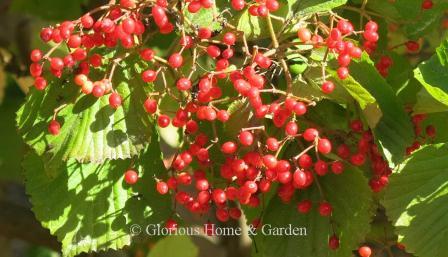 Viburnum x 'Oneida'
Viburnum x 'Oneida'Viburnum opulus, European cranberry bush, Zones 3-8. Bright red fruits ripen in the fall and persist through the winter. 'Compactum' is smaller shrub than the species and has brilliant fruit; 'Xanthocarpum' is a yellow-fruited form.
Viburnum sargentii, Sargent viburnum, Zones 3-7. Quite a large shrub (can reach 15' x 15' proportions), it nevertheless produces clusters of persistent red berries late summer into fall as well as good fall leaf color--if you have the room for it. Best in Northern zones.
Viburnum setigerum, tea viburnum, Zones 3-7. Not the most beautiful viburnum as far as form (leggy) or leaf color (unreliable) are concerned--this one is grown for its showy clusters of red fruit which ripen in early-to-mid fall. The leaves have been used to make tea.
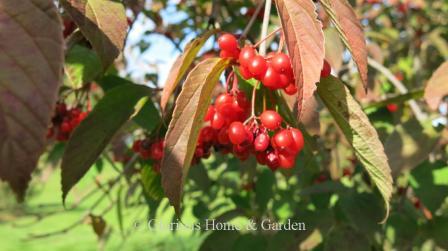 Viburnum setigerum
Viburnum setigerumViburnum x rhytidopylloides, a cross between V. lantana and V. rhytidophyllum, Zones 5-8. Fruits mature from yellow to red to black in late summer and fall. A good choice for the South as it tolerates heat better than some others. 'Alleghany,' and 'Willowwood' are good selections. Be sure to have a couple of cultivars in the area for good pollination.
Viburnum tinus, laurustinus, Zones 8-10. This is a nice evergreen shrub for the milder areas of the country. It makes a nice hedge, and I have had good luck with it in Zone 7b. Fall brings clusters of metallic blue fruits that are quite ornamental as on 'Spring Bouquet' below.
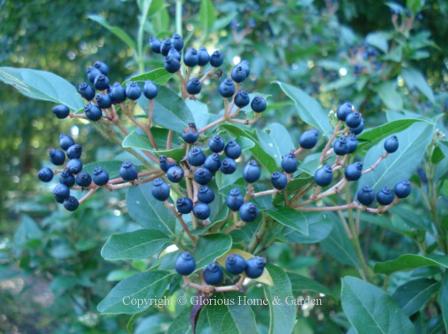 Viburnum tinus 'Spring Bouquet'
Viburnum tinus 'Spring Bouquet'Viburnum trilobum, American cranberry bush, Zones 2-7. An outstanding native shrub excellent for fall into winter fruit display. The edible cranberry-like fruits provide food for birds in late winter. Best in the North as it does not relish heat and humidity. 'Wentworth' is an excellent cultivar.
Plant of the Month
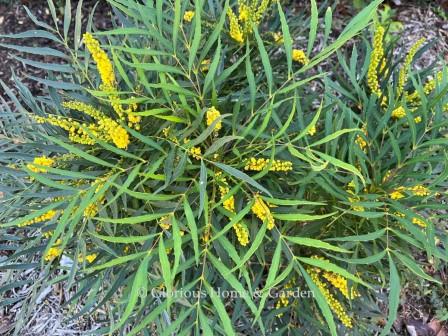
Mahonia eurybracteata
'Soft Caress'
Updated new USDA Plant Hardiness Zone Map 2023.